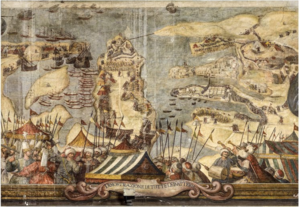Our website is made possible by displaying online advertisements to our visitors.
Please consider supporting us by disabling your ad blocker.
Great Siege of Malta
| Great Siege of Malta | |||||||
|---|---|---|---|---|---|---|---|
| Part of the Ottoman–Habsburg wars | |||||||
 Dimostrazione di tutte le batterie, fresco by Matteo Pérez d'Aleccio at the Grandmaster's Palace in Valletta | |||||||
| |||||||
| Belligerents | |||||||
|
Ottoman Empire | |||||||
| Commanders and leaders | |||||||
|
Relief force: | ||||||
| Strength | |||||||
| 35,000–40,000 |
2,500 (6,100, including militia, servants, and galley slaves)
| ||||||
| Casualties and losses | |||||||
| 25,000[3]–35,000 killed in combat and from disease[4][5] | At least 2,500 | ||||||
The Great Siege of Malta (Maltese: L-Assedju l-Kbir) occurred in 1565 when the Ottoman Empire attempted to conquer the island of Malta, then held by the Knights Hospitaller. The siege lasted nearly four months, from 18 May to 8 September 1565.
The Knights Hospitaller had been headquartered in Malta since 1530, after being driven out of Rhodes, also by the Ottomans, in 1522, following the siege of Rhodes. The Ottomans first attempted to take Malta in 1551 but failed. In 1565, Suleiman the Magnificent, the Ottoman Sultan, made a second attempt to take Malta. The Knights, who numbered around 500 together with approximately 6,000 footsoldiers, withstood the siege and repelled the invaders.
This victory became one of the most celebrated events of sixteenth-century Europe, to the point that Voltaire said: "Nothing is better known than the siege of Malta." It undoubtedly contributed to the eventual erosion of the European perception of Ottoman invincibility, although the Mediterranean continued to be contested between Christian coalitions and the Muslim Turks for many years.[6]
- ^ At least two companies of Spanish Tercios took part in the defence of Fort St Elmo. Cañete, Hugo A. (3 July 2020). "La leyenda negra del fuerte de San Telmo y los tres capitanes españoles del Tercio Viejo de Sicilia que lo defendieron (Malta 1565) | Grupo de Estudios de Historia Militar". Grupo de Estudios de Historia Militar (in Spanish). Retrieved 4 July 2020.
- ^ Cite error: The named reference
paoletti2008was invoked but never defined (see the help page). - ^ Arnold Cassola, The 1565 Great Siege of Malta and Hipolito Sans's La Maltea (Publishers Enterprise Group: Malta, 1999).
- ^ Cite error: The named reference
SOMwas invoked but never defined (see the help page). - ^ Cite error: The named reference
Giacomo Bosio 1643was invoked but never defined (see the help page). - ^ Fernand Braudel, The Mediterranean and the Mediterranean World in the Age of Philip II, vol. II (University of California Press: Berkeley, 1995).
Previous Page Next Page


